Galaxy Evolution


Galaxy Evolution
Overview
The galaxy evolution group at RIT investigates numerous questions related to our cosmic origins, such as how galaxies formed and evolved over time, what drives star formation and subsequent quenching in galaxies, and what fuels the growth of their supermassive black holes. We are particularly interested in the role that galaxy environment plays, from the small scale of galaxy mergers and interactions to the large scale galaxy clusters, filaments, and voids. We use observational facilities across the entire spectrum, including the Keck telescopes in Hawaii, the Gemini telescopes in Hawaii and Chile, the Atacama Large Millimeter Array in Chile, and space telescopes such as Hubble and the soon to be launched James Webb Space Telescope.
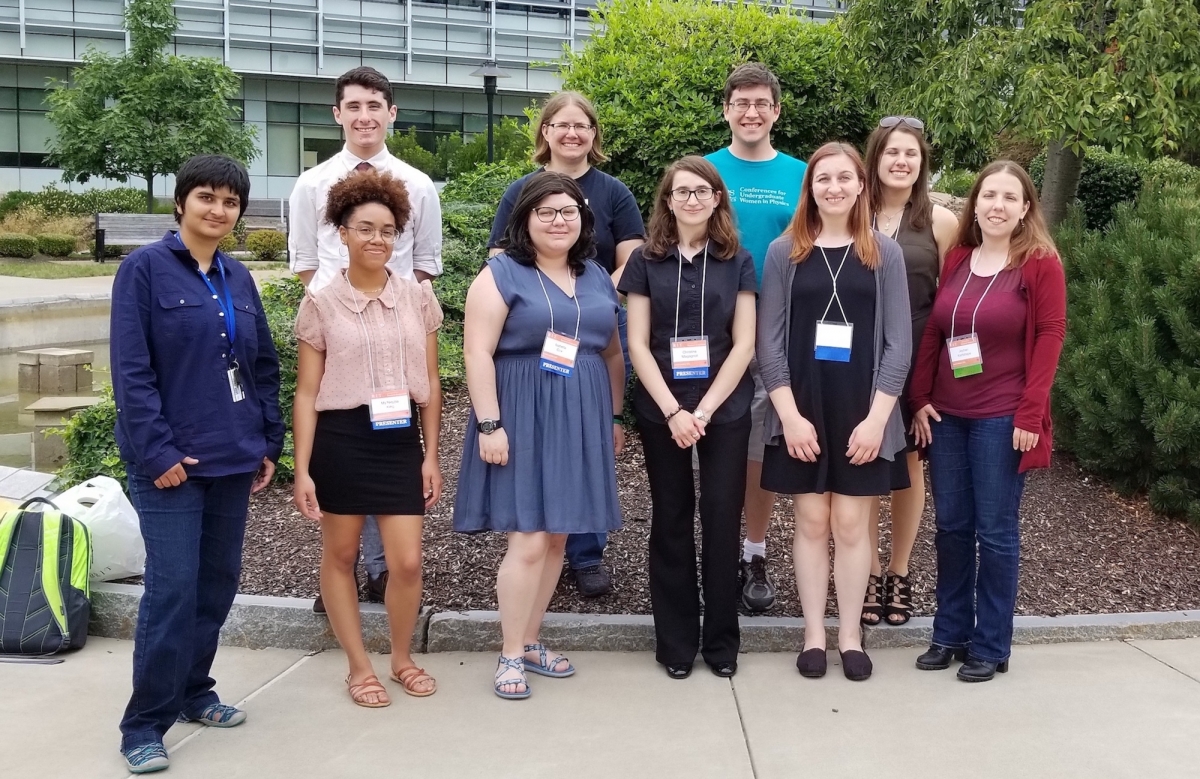
A photo of the Galaxy Evolution Research group from the 2018 Undergraduate Research Symposium. Back Row: Undergraduate student Noah Reuter, Postdoc Krystal Tyler, Graduate student Kevin Cooke, Undergraduate student Grace Fiacco. Front Row: Graduate student Ekta Shah, Undergraduate Students My'Neyzia King, Isabella Cox, Christina Magagnoli, Jessica Chellino, and Assistant Professor Jeyhan Kartaltepe.
A photo of the Galaxy Evolution Research group from the 2018 Undergraduate Research Symposium. Back Row: Undergraduate student Noah Reuter, Postdoc Krystal Tyler, Graduate student Kevin Cooke, Undergraduate student Grace Fiacco. Front Row: Graduate student Ekta Shah, Undergraduate Students My'Neyzia King, Isabella Cox, Christina Magagnoli, Jessica Chellino, and Assistant Professor Jeyhan Kartaltepe.
Galaxy Mergers at High Redshift
The now well-established model of hierarchical galaxy formation posits that galaxies grow over time by merging with other galaxies, through major mergers of comparable mass, minor mergers, or satellite accretion. However, the precise role that mergers and interactions play in driving galaxy evolution, and how that role has changed over the age of the universe, has been widely debated. Galaxy mergers can impact galaxies in a number of ways, including their morphology, their sizes, the motion of their stars and gas, their gas content, their star formation rates, and their nuclear activity. This range is due to many factors, including 1) the definition/selection of mergers, 2) the difficulty of selecting a consistent sample across all redshifts, and 3) what the particular science question is. Galaxy mergers are particularly difficult to identify at high redshift since their large distances results in them looking smaller and fainter, and low surface brightness features such as tidal tails become very difficult to identify. The most robust method for identifying galaxy mergers at high redshift is through visual classification, and our group has conducted many studies that look at samples of galaxy mergers selected this way (e.g., Kartaltepe et al. 2010, 2012, 2015; Magagnoli et al. in preparation). While this method is incredibly time consuming, it is still the most reliable method for identifying galaxies with non-regular morphologies at high redshift since the human eye is adept at patter recognition. While, quantitative methods are less reliable for picking out galaxy mergers (see Kartaltepe et al. 2010, for example) new machine learning techniques show promise (e.g., Peth et al. 2016, Huertas-Company et al. 2009, 2015, Huertas-Company et al.).

A collection HST VJH images of galaxy mergers selected visually from the CANDELS fields.
In order to quantify the impact that galaxy mergers have had over the age of the universe, it is important to first quantify the merger rate and how it evolves with redshift. While seemingly a straight-forward measurement, this question has been one of much debate since the earliest studies in the 1980s (Zepf & Koo 1989). Today, there is a good handle on how the merger rate evolves out to z~1 (strongly, as (1+z)3, e.g., Kartaltepe et al. 2007) and how selection effects associated with different parent samples and merger identification techniques can impact the results (e.g., Lotz et al. 2011). However, at higher redshift (out to z~3 and beyond) studies have found a perplexing range of results.
Most observational studies find strong evolution with redshift out to z~1 and then a flattening out to z ∼ 3 (e.g., Mantha et al. 2018, Duncan et al. 2019), while modern simulations have found that the merger rate continues to increase out to z~3 (e.g., Rodriguez-Gomez et al. 2015). In order to resolve this discrepancy, one must invoke a change in the pair observability timescale (Snyder et al. 2017, Duncan et al. 2019). This is likely due to a combination of factors, including a change in the observability of pair galaxies with high specific star formation rates and gas fractions and a change in the time that passes between when a pair is observed and the final coalescence of the system, though more work is required to truly understand merger rates at high redshift.
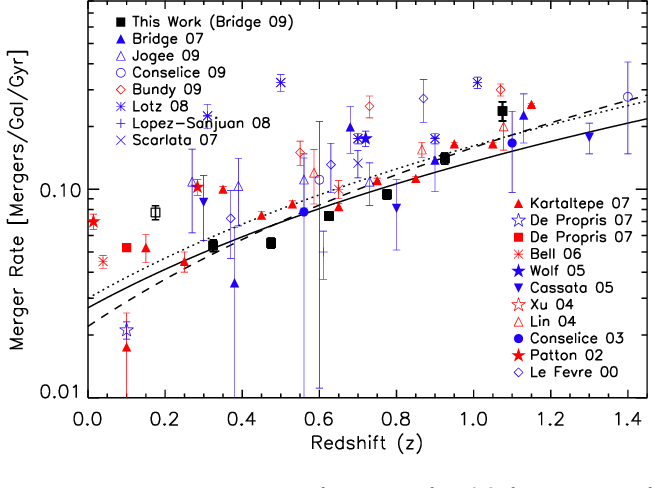
Figure from Bridge et al. 2010: Compilation of merger rate values from the literature, including Kartaltepe et al. 2007, illustrating how the merger rate evolves out to z~1.
Group members: Jessica Chellino, Isabella Cox, Jeyhan Kartaltepe, Christina Magagnoli, Ekta Shah, Caitlin Rose, Brittany Vanderhoof
Former group members: Carly Klein-Stern, Meaghann Stoelting
The Effect of Galaxy Interactions on Enhancing Star Formation and Black Hole Growth
Our group has compiled the largest sample of spectroscopically confirmed galaxy pairs out to z~3 spanning a projected separation of 5-150 kpc in the COSMOS and CANDELS survey fields. With this sample, we are investigating the level of enhancement in both the star formation rate and AGN activity during the merger process by comparing these quantities to a well-defined control sample of isolated galaxies. A preliminary analysis of the AGN enhancement (fraction of X-ray detected AGN in paired galaxies relative to that in the control sample) for pairs in the GOODS-N and -S fields suggests that high redshift interactions may have less of an impact on driving AGN activity than at low redshift (Shah et al. 2019, in preparation). At the same time, a sample of late-stage mergers selected from visual classifications of the CANDELS fields (Kartaltepe et al. 2015) show a strong enhancement in AGN activity, specifically for obscured AGN selected based on their mid-infrared colors (Magagnoli et al. in preparation).
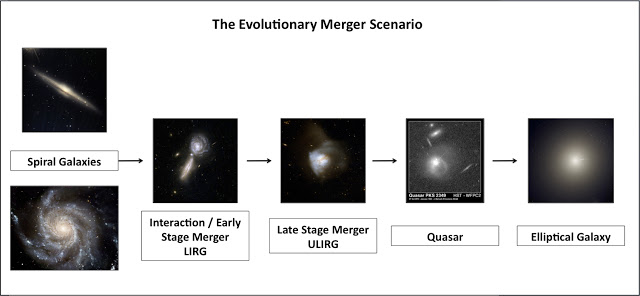
Diagram illustrating the merger scenario, where the merger of two gas rich spirals forms a luminous infrared galaxy, which evolves into a ULIRG, then a Quasar, and eventually an elliptical galaxy. All images are from Hubble.
Group Members: Jeyhan Kartaltepe, Christina Magagnoli, Ekta Shah, Brittany Vanderhoof
Identifying Galaxy Mergers in Simulated Images in Preparation for the James Webb Space Telescope
One way to identify low redshift galaxy mergers is to search for morphological signatures of a merger via quantitative morphological parameters, which quantify a galaxy’s light distribution (such as Sersic profiles, or the CAS system, G and M20, and the M I D statistics). However, for high redshift galaxies, these parameters can be affected by biases due to poor resolution and image noise. The upcoming James Webb Space Telescope (JWST) will be able to probe higher redshifts than ever before for morphological studies with high spatial resolution. The Cosmic Evolution Early Release Science (CEERS) Survey will use JWST’s near-infrared camera to reveal detailed galaxy morphologies over a wide range of redshifts. In preparation for CEERS images, our group seeks to understand how well those common morphological statistics will be able to identify JWST mergers. We will use these statistics to test and refine various machine learning algorithms.

Simulated F277W James Webb Space Telescope image of a galaxy merger at high redshift (z=3.71) derived from the Illustris Simulation (Snyder et al. 2017). Image on the left is the original mock image and image on the right is after adding a noise level equivalent to the CEERS proposed exposure time (Rose 2019).
Group Members: Jeyhan Kartaltepe, Caitlin Rose
The Impact of Local Environment on Galaxy Properties
It has long been known that there is a tight correlation between galaxy morphology and local environment (Dressler 1980). Elliptical galaxies tend to reside in the densest environments while spiral galaxies dominate in the field. Since a galaxy’s morphology is also correlated with its SFR, the densest environments are dominated by passive systems while galaxies actively forming stars reside in less dense environments, like group and field environments. These relations, the morphology-density relation and the SFR-density relation have been observed by a plethora of studies in the local universe. In recent years investigations have pushed outward to see how these relations have evolved over cosmic time, but so far, these studies have found conflicting results and the picture at high redshift remains unclear. Some authors have argued that at z > 1, when today’s elliptical galaxies were forming the bulk of their stars, the SFR-density relation should be reversed compared to the local relation. While some groups find evidence for this, others find no reversal at all or a flatting of the relationship at higher redshift. Our group is using the plethora of photometric and spectroscopic redshifts available in the COSMOS and CANDELS deep fields to construct environmental density maps and quantify how galaxy environment impacts star formation, AGN activity, and morphology out to z~3.

Environmental density map of the GOODS-S field in one redshift slice (1.35 < z < 1.45) created using the Voronoi Tesselation method.
Group members: Jessica Chellino, Jeyhan Kartaltepe, Dalton Trask, Caleb Wetherell
Former group members: Grace Fiacco, Justin Gallagher
Brightest Cluster Galaxies and their Progenitors
The brightest and most massive galaxies in the universe, the Brightest Cluster Galaxies (BCGs), tell a unique story of galaxy evolution. Today, BCGs are quiescent ellipticals hosted in relaxed galaxy clusters, with pasts fraught with mergers and high star formation rates (SFRs).
In a recent publication, Cooke et al. investigate how this active past may depend on local environment by estimating star formation in BCG progenitors in the COSMOS field out to a redshift of z ~ 3 (more than 11 billion years in the past). To estimate star formation rates, they fit progenitor observations with various models from the far-ultraviolet to far-infrared wavelengths. They find that BCG progenitors gain stellar mass in three phases, with effects due to local environment manifesting at z < 1.25 (9 billion years in the past).
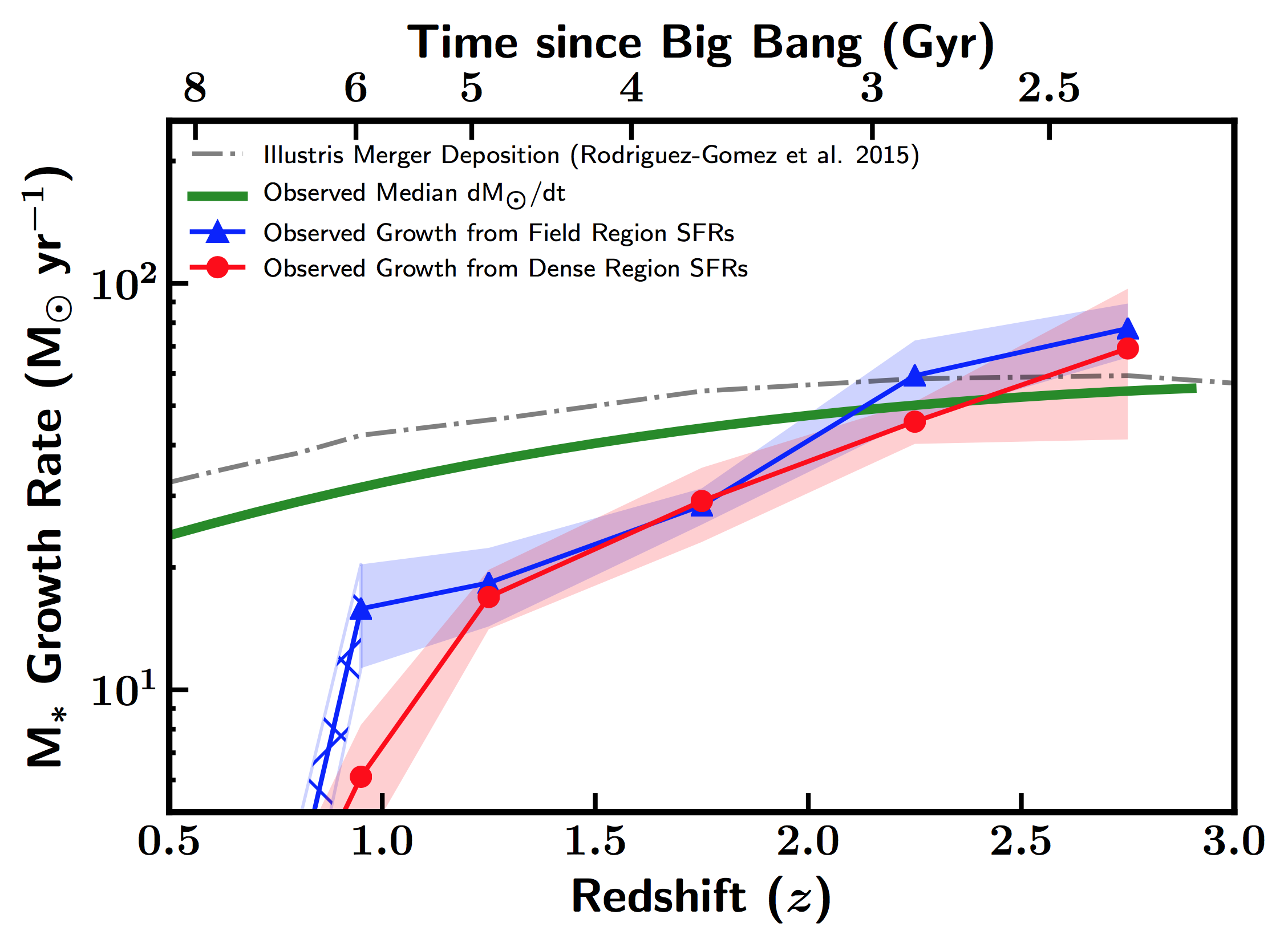
The observed stellar mass growth rate for massive galaxy progenitors in dense regions (red) and field regions (blue) compared to the median growth rate of our sample’s median stellar masses (green). The galaxies selected in dense environments are those most likely to form the BCGs we see today, while those in the field sample are candidates to merge into a BCG during cluster mergers at later times. Overplotted are the stellar mass deposition rate of mergers in the Illustris simulation (grey dash dotted) with a stellar mass capture efficiency of 100%. We identify three epochs of stellar mass growth; a star-formation dominated phase at z > 2.25, a phase between 1.25 < z < 2.25 where star formation is responsible for ∼50% of the total stellar mass growth and gas rich and poor mergers are required to match the total (green), and finally a dry merger dominated phase at z < 1.25 where star formation is insignificant to the total stellar mass growth. From Cooke et al. 2019.
Group Members: Kevin Cooke, Jeyhan Kartaltepe
Former group members: Krystal Tyler
Galaxy Kinematics at z=1-3
The kinematics of a galaxy can also indicate the presence of a past merger. We are investigating galaxies both on and off the star forming main sequence (SFMS) to quantify the role of mergers in enhancing the star formation in starburst galaxies. Using observations taken with the MOSFIRE instrument on the Keck I telescope, we are measuring the rotation velocity and velocity dispersion of a sample of Herschel-selected luminous and ultraluminous infrared galaxies at z~1.5 and correlating their kinematic information with their morphology based on Hubble Space Telescope images. Each galaxy was observed with three different slit position angles (PAs) to increase the likelihood of capturing kinematic rotation information (see example below), especially in galaxies with disturbed morphologies.

Example of one starburst galaxy in the sample of galaxies in the kinematic analysis. On the left is an HST image of the galaxy overlaid with the three slits that we observed using the MOSFIRE instrument on the Keck telescope. On the right is the corresponding 2D spectra for each slit showing the detected emission lines.
Group Members: Jeyhan Kartaltepe, Brittany Vanderhoof
Resolved Stellar Populations of High Redshift Luminous Infrared Galaxies
The high resolution of Hubble Space Telescope images enables detailed morphological studies. For fields with images in multiple filters, this resolution also enables detailed studies of galaxy properties on a resolved scale. For most distant galaxies, quantities like stellar mass and star formation rate are calculated on a global scale, with fits to the full spectral energy distribution (SED) of integrated light from the galaxy. If the galaxy is resolved in multiple filters, we can instead fit SEDs on an individual pixel basis and calculate resolved stellar masses, star formation rates, and levels of extinction across the galaxy. Doing so allows for an investigation into different star formation triggering and quenching mechanisms.

Resolved maps for one example galaxy in the GOODS-S field. From top left: VJH color image of galaxy, J-H color map of galaxy, age map, stellar mass map, star formation rate map, and extinction map (Stoelting 2019). Note the merger features in the galaxy image and the clumps in the stellar mass maps. The star formation rate appears to be concentrated in one of these clumps.
Group Members: Isabella Cox, Jeyhan Kartaltepe
Former group members: Meaghann Stoelting
The Contribution of AGN to Measured Galaxy Properties
In order to understand the importance that actively accreting supermassive black holes (SMBH) can have on their host galaxies, it is important to be able to quantify the contribution that active galactic nuclei (AGN) can have on the emission measured from the entire host galaxy. Additionally, when the AGN is not taken into account, measurements of important galaxy properties, such as stellar mass and star formation rate, can be mis-estimated. In order to determine how best to account for an AGN and quantify its contribution to the total spectral energy distribution (SED) of a galaxy, we are testing multiple SED fitting codes and comparing the results. Shown below is an example SED fit with two different codes, MAGPHYS (da Cuhna et al. 2008) and SED3FIT (Berta et al. 2013). In this example, including an AGN component is crucial; without it, the stellar mass and star formation rate are severely overestimated. We have tested a large sample of infrared-selected galaxies over the COSMOS field and overall, we find that AGN dominated system among our sample are rare, but when they occur they can significantly affect measured galaxy properties (Tyler et al. in preparation).
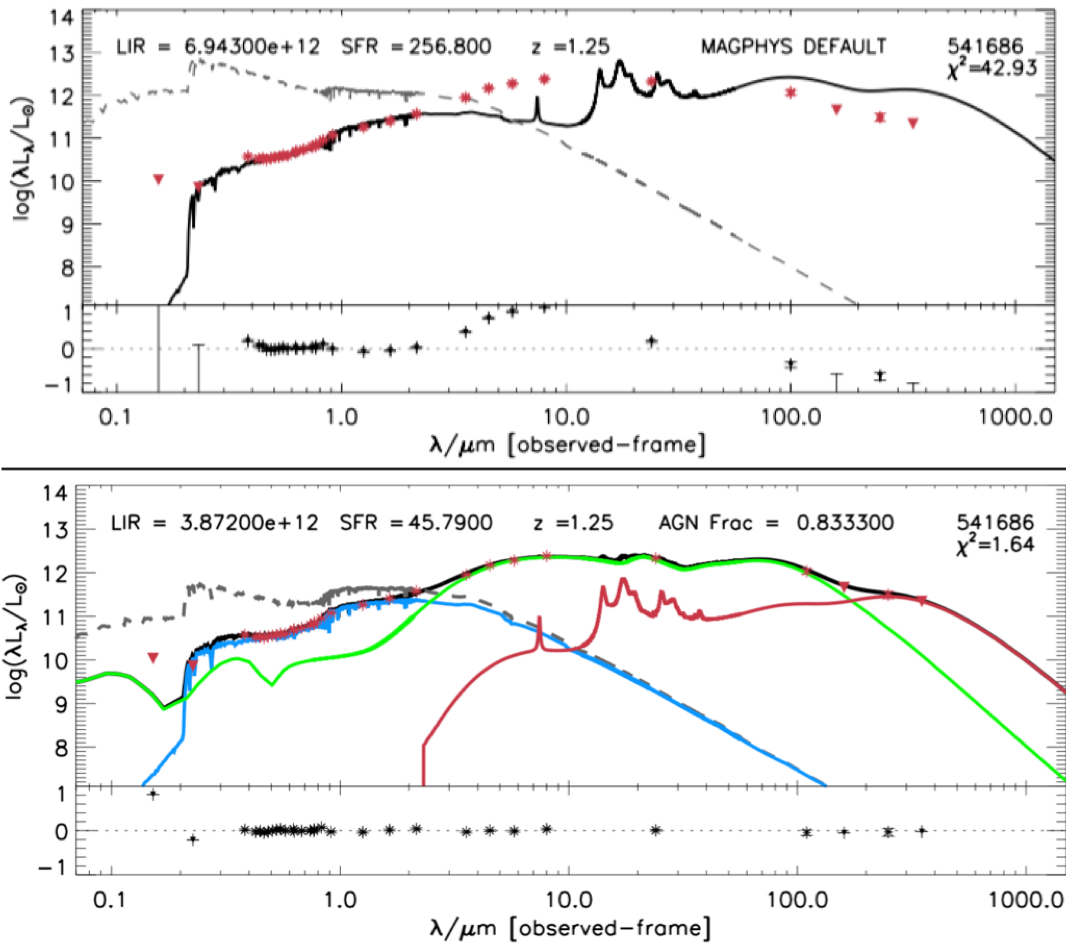
An example SED of an infrared-selected galaxy at z=1.25 with fits using MAGPHYS (top) and SED3FIT (bottom). SED3FIT includes an AGN component (green line), in addition to star formation and dust models (blue and red lines), while MAGPHYS only fits for star formation and its re-radiated dust component (black line). For this particular object, including an AGN component results in a much better fit. Not including one results in a severe mis-estimation of both SFR and stellar mass.
Group Members: Kevin Cooke, Jeyhan Kartaltepe
Former group members: Dale Mercado, Krystal Tyler
Optical and Near-Infrared Spectroscopic Follow-up Surveys of Galaxies
We are conducting a number of optical and near-infrared spectroscopic follow-up surveys of galaxies in the COSMOS and CANDELS fields. These include surveys using the Fiber Multi-Object Spectrograph on Subaru (FMOS; Kartaltepe et al. 2015, Silverman et al. 2015, Kartaltepe et al. 2019, in preparation) to observe known AGN and infrared-selected galaxies, the DEIMOS and GMOS instruments on Keck and Gemini to obtain spectroscopic redshifts of interacting galaxy pairs (Shah et al. in preparation, Cox et al. in preparation), and using GMOS, MOSFIRE on Keck, and LUCI on the LBT to obtain spectra of high redshift luminous and ultraluminous infrared galaxies ((U)LIRGs) across a range of environments (Cox et al. in preparation, Vanderhoof et al. in preparation).
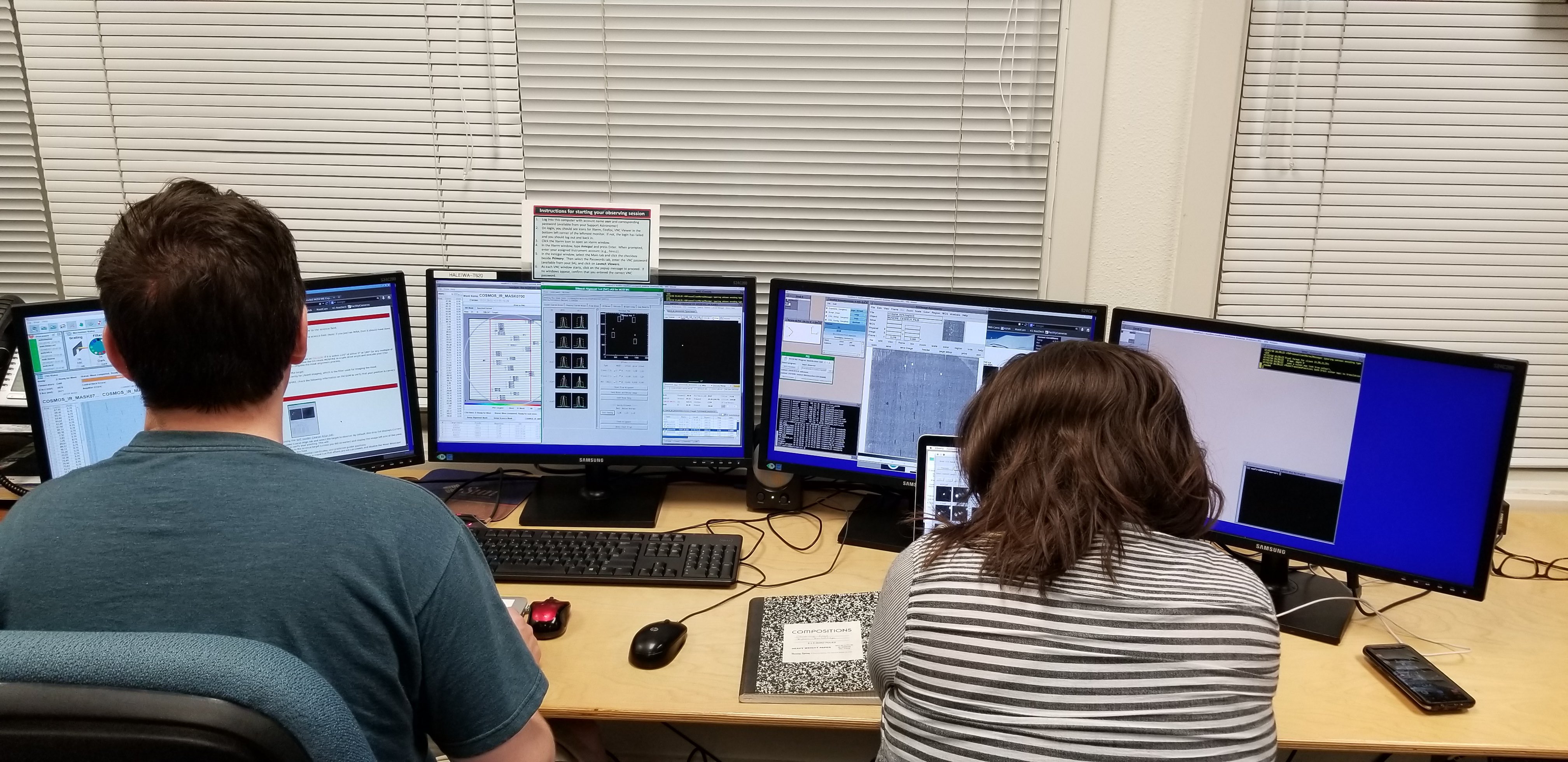
Graduate students Kevin Cooke and Brittany Vanderhoof observing at the Keck I telescope using the MOSFIRE instrument in February 2018.
Group Members: Kevin Cooke, Isabella Cox, Jeyhan Kartaltepe, Ekta Shah, Brittany Vanderhoof